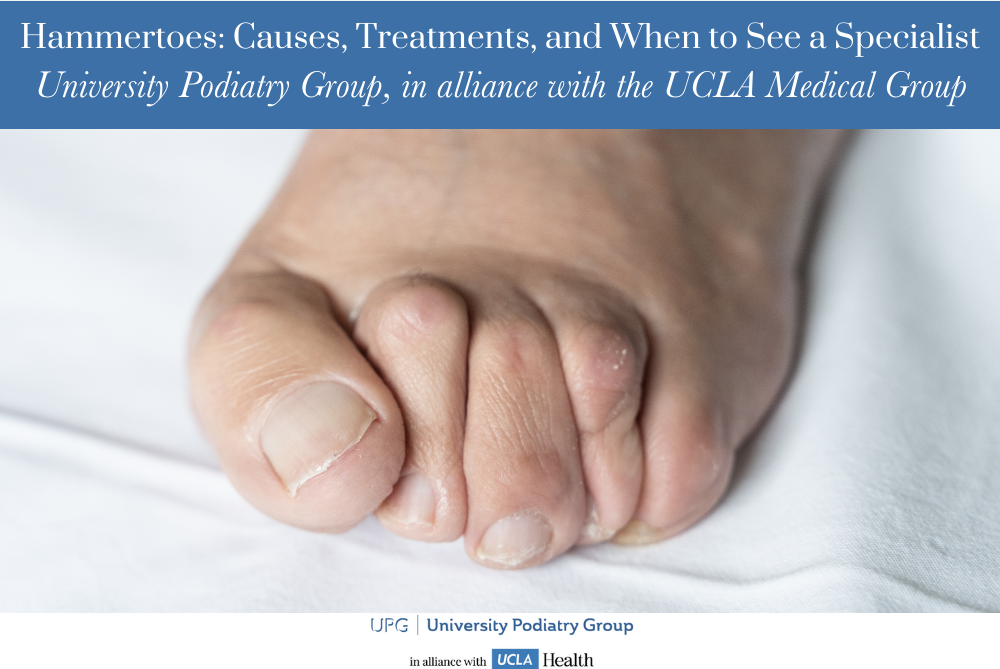 University Podiatry Group, in alliance with the UCLA Medical Group
University Podiatry Group, in alliance with the UCLA Medical Group
Hammertoes are one of the most common toe deformities seen by podiatrists. They may begin as a mild inconvenience—perhaps a toe that bends oddly in your shoe or causes a bit of discomfort while walking—but left untreated, hammertoes can become a source of chronic pain and immobility. At University Podiatry Group, in alliance with the UCLA Medical Group, our experienced podiatrists specialize in diagnosing and treating hammertoes to help you get back on your feet comfortably and confidently.
What Are Hammertoes?
A hammertoe is a deformity of the toe where one or more toes are bent downward at the middle joint (the proximal interphalangeal joint), giving it a hammer-like appearance. Most commonly affecting the second, third, or fourth toes, hammertoes can be either flexible (early stage) or rigid (advanced stage).
Common Causes of Hammertoes
Several factors contribute to the development of hammertoes, including:
- Improper Footwear: Tight shoes or high heels that force the toe into a bent position.
- Muscle Imbalance: Uneven pulling from the muscles, tendons, or ligaments that keep the toe straight.
- Genetics: A hereditary predisposition to structural foot abnormalities.
- Injury: Trauma to the toe can alter its natural alignment.
- Underlying Conditions: Diseases such as arthritis or diabetes can increase the risk of hammertoes.
Symptoms to Watch For
Hammertoes often develop gradually, but early recognition and treatment can prevent progression. Common symptoms include:
- Bent or curled toe (usually the second, third, or fourth)
- Pain while wearing shoes
- Corns or calluses from toe rubbing against footwear
- Swelling, redness, or inflammation
- Restricted or painful movement of the toe
Treatment Options for Hammertoes
Treatment depends on the severity and flexibility of the hammertoe.
Non-Surgical Treatments
- Footwear Changes: Opt for shoes with a wide toe box and low heels.
- Orthotic Inserts: Custom shoe inserts to correct muscle imbalance and relieve pressure.
- Toe Exercises: Stretching and strengthening exercises can help flexible hammertoes.
- Padding: Corn pads or toe cushions can reduce friction and discomfort.
Surgical Treatments
When conservative methods fail or the hammertoe becomes rigid and painful, surgery may be recommended. Surgical procedures include:
- Tendon release or transfer
- Joint resection
- Fusion of toe bones
Our surgeons at University Podiatry Group use advanced techniques to ensure minimal downtime and optimal outcomes.
Why Choose University Podiatry Group?
As part of the UCLA Medical Group, our multidisciplinary team delivers world-class podiatric care across multiple convenient locations in Southern California. We combine cutting-edge diagnostic tools, compassionate care, and personalized treatment plans to address each patient’s unique foot and ankle needs.
Frequently Asked Questions (FAQ)
Q: Can hammertoes go away on their own?
A: No. While early-stage (flexible) hammertoes may be managed with non-surgical treatments, the deformity itself will not reverse without medical intervention.
Q: What’s the difference between a flexible and rigid hammertoe?
A: A flexible hammertoe can still move at the joint and is usually in the early stages of development. A rigid hammertoe is fixed in position and often requires surgical correction.
Q: When should I see a podiatrist for a hammertoe?
A: If you’re experiencing persistent toe pain, visible deformity, or difficulty wearing shoes comfortably, it’s time to consult a podiatrist. Early diagnosis and intervention can prevent complications.
Q: Is surgery for hammertoes painful?
A: Most patients experience minimal pain with modern surgical techniques. Recovery varies but generally includes rest, ice, limited activity, and follow-up care to ensure proper healing.
Q: Will I be able to walk after hammertoe surgery?
A: Yes, but activity may be limited initially. Most patients wear a special surgical shoe and gradually resume normal activities within weeks.
Contact University Podiatry Group
Our team is here to provide you with expert evaluation and personalized treatment for hammertoes and all foot and ankle conditions. Schedule your consultation at one of our convenient locations:
Westwood Office
100 Medical Plaza Driveway #460
Los Angeles, CA 90024
📞 (310) 443-8999
Santa Monica Office
2001 Santa Monica Blvd #1060
Santa Monica, CA 90404
📞 (310) 582-1940
Torrance Office
3500 Lomita Blvd Suite M100
Torrance, CA 90505
📞 (310) 517-8578
Santa Clarita Office
25775 McBean Pkwy Suite 115A
Santa Clarita, CA 91355
📞 (661) 753-5464
Porter Ranch Office
19950 Rinaldi St Suite 300
Porter Ranch, CA 91326
📞 (818) 271-2400
Westlake Village Office
1250 La Venta Drive, Suite 106
Westlake Village, CA 91361
📞 (805) 494-6920
Don’t let hammertoes affect your quality of life. Whether you’re dealing with mild discomfort or advanced symptoms, University Podiatry Group is here to help you walk comfortably again. Reach out today!
